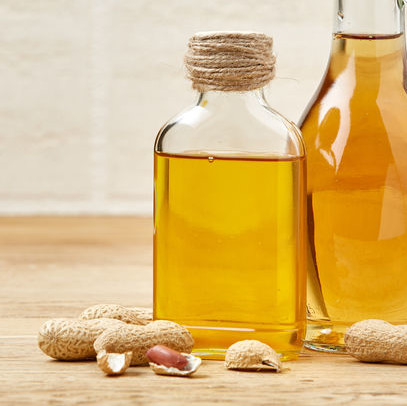Peanut Oil
Also known as groundnut or arachis oil
What is Peanut Oil?
Peanut oil is a liquid fat obtained from pressed peanuts seeds. It is composed of 80% unsaturated (oleic acid and linoleic acid) fatty acids and 20% in saturated (palmitic) fatty acids.1
It has a pale yellow color and a nut-like flavor that accentuates the flavor of savory foods. Its high smoke point (229°C/462°F) makes it suitable for deep frying and baking.1 Three types of peanut oil are available commercially:2
- Crude oil
- Refined oil
- Roasted oil
Origin
Peanuts (Arachis hypogaea L.) domestication is attributed to South America. It was then carried to Africa from Brazil by explorers and later to North America by slave traders. Today, China, India, U.S, Nigeria and Indonesia are the main producers of peanuts. A large part of the peanut crop is used whole or for the production of peanut butter in the U.S.1
Function
Peanut oil serves several purposes in baked goods:3
- Tenderizer: by coating structure building components (gluten, starch and egg proteins) and prevents them from hydrating and building structures.
- Moistness, softness and extensibility: by lubricating proteins and polysaccharides, it can provide moistness sensation as well as softness.
- Prevents staling: by retarding starch retrogradation gelatinization.
- Flavor: provides a mild nutty flavor which can enhance the flavor of nuts-containing bakery products.
- Color: indirectly by increasing heat necessary to bake, it can help increase browning.
- Smoothness: by interfering with and disrupting sugar crystallization.
- Flavor carrier: similar to other oils, it can be used as flavor carrier.
- Release agent: aids in the removal of baked goods from molds.
Nutrition
Composition of fatty acids in peanut oil:2
| Fatty acid | Percentage |
| Oleic | 41.3 – 67-4 |
| Linoleic | 13.9 – 35.4 |
| Palmitic | 7.4 – 12.5 |
| Stearic | 2.7 – 4.9 |
| Behenic | 2.1 – 3.6 |
| Arachidic | 1.2 – 1.9 |
| Lignoceric | 0.9 – 1-7 |
Consumption of peanut oil is associated with reduced risk of heart disease, a result of its role in decreasing low-density lipoprotein (LDL) and triacylglycerol (TAG) while increasing high-density lipoprotein (HDL).1,2
Allergies to peanuts is a common health and is caused by a protein component in the nut. Refined peanut oil doesn’t pose allergy risk. However, crude oil was reported to impart allergic reactions in some consumers.2
Commercial production
Peanut oil can be commercially obtained through the following process:4
- Cleaning: removal of foreign matter such as dirt and stalks.
- Dehulling: removal of hulls using mechanical impact and air separation.
- Cooking: beans are cooked and dried down to 3.5-4.5% moisture at 90-100°C (194-212°F).
- Pressing and filtering: beans go through a screw press to extract the oil followed by filtration.
- Alkali treatment and centrifugation: the crude oil- caustic soda mix are then centrifuged.
- Second centrifugation: for removal of soap.
- Bleaching: removal of pigments and other contaminants with bleaching clay.
- Deodorization: removal of undesirable odors.
Application
Peanut oil can be used in several baking systems such as cakes, cookies, muffins and breads. It’s most complimentary to savory and nuts-containing baked goods. Its use, however, is limited due to its high price.1,2
Margarines and shortenings made with peanut oil are used in various baking applications and can replace butter or shortenings in many formulations.1,2
Regulations
Highly refined peanut oil is considered GRAS by the FDA. In the European Union, peanut and peanut derivatives by the EC Commission Regulation 1169/2011.5,6
References
- O’brien, R. D. Fats and oils: formulating and processing for applications. CRC press, 2009, pp. 22-24.
- Gunstone, F. Vegetable oils in food technology: composition, properties and uses. John Wiley & Sons, 2011.
- Figoni, P. How Baking Works: Exploring The Fundamentals Of Baking Science. 2nd ed., John Wiley & Sons, Inc., 2008.
- Stalker, T and Wilson, R.F. Peanuts: genetics, processing, and utilization.AOCS Press, 2016.
- Food and Drug Administration (FDA). US Department of Health and Human Services. CFR Code of Federal Regulations Title 21, Part 182 Substances Generally Recognized As Safe, https://www.accessdata.fda.gov/scripts/cdrh/cfdocs/cfcfr/CFRSearch.cfm?fr=182.70&SearchTerm=peanut%20oil, Accessed 25 August 2020.
- European Commission (EC). Commission Regulation 1169/11/EC on the provision of food information to consumers, amending Regulations (EC) No 1924/2006 and (EC) No 1925/2006 of the European Parliament and of the Council, and repealing Commission Directive 87/250/EEC, Council Directive 90/496/EEC, Commission Directive 1999/10/EC, Directive 2000/13/EC of the European Parliament and of the Council, Commission Directives 2002/67/EC and 2008/5/EC and Commission Regulation (EC) No 608/2004, 25 October 2015.


